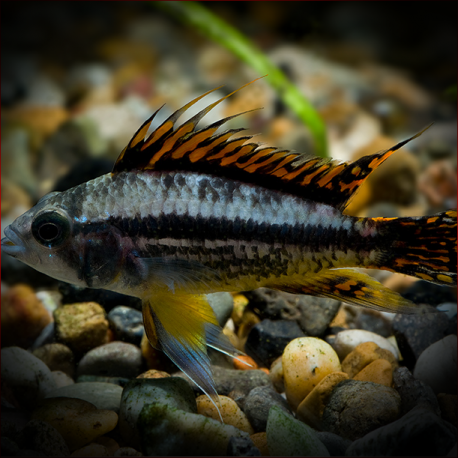More info
Datasheet
| Minimum Tank Size | 60 litres / 15.85 US gallons |
| Maximum Size | 7.5cm / 2.95inches |
| Temperature | 22°C / 71.60°F - 29°C / 84.20°F |
| Hardness | 0.00dgH / 0ppm - 15.02dgH / 268ppm |
| pH | 5.0-6.5 |
General Description
The Cockatoo Cichlid, scientifically known as Apistogramma Cacatuoides, belongs to the family Cichlidae and is classified under the Perciformes order. It is a colorful and popular choice among aquarium enthusiasts, with numerous ornamental forms selectively bred for the trade, including variations like "sunset," "sunburst," and "albino." This species is relatively small, reaching a maximum size of about 7.5cm.
Aquarium Setup
Creating a suitable aquarium environment for Cockatoo Cichlids involves providing ample cover and structure. Decor options such as ceramic flowerpots, plastic piping, wood roots, and branches can be included to offer hiding spots and caves. A natural setup with a soft, sandy substrate, dried leaf litter (like beech or oak leaves), and dim lighting can mimic their habitat. Plants from genera like Microsorum, Taxiphyllum, Cryptocoryne, and Anubias are recommended, along with some floating vegetation to diffuse light. Maintaining water conditions within a pH range of 5.0-6.5, hardness of 0-268 ppm, and a temperature between 22-29°C is essential. Regular water changes of 10-15% weekly are suggested for a lightly-stocked tank.
Behaviour
In captivity, Cockatoo Cichlids are best suited for community aquariums if they are captive-raised. When wild-caught, it is advisable to keep them alone or with small "dither" fishes like Nannostomus spp. These cichlids should ideally not be mixed with other members of the Apistogramma genus to prevent potential aggression or hybridization issues.
Feeding and Diet
Cockatoo Cichlids are primarily carnivorous, with a natural diet consisting of benthic invertebrates. In an aquarium setting, they can be fed live or frozen foods like Artemia, Daphnia, and chironomid larvae. While they may also accept dried foods, pelleted products are usually preferred over flakes for their diet.
Reproduction & Dimorphism
During reproduction, Cockatoo Cichlids prefer softer, acidic water conditions. They are substrate spawners, with the female laying eggs in crevices or cavities among the decor. Post-spawning, the female takes care of the eggs and fry, sometimes requiring the male to be removed in smaller tanks due to potential hyper-aggression. Male Cichlids exhibit larger size, vibrant colors, and more extended fins compared to females.
Habitat and Distribution
These cichlids are typically found in slower-moving tributaries, backwaters, and creeks with fallen leaf litter in their natural habitat. Cockatoo Cichlids are native to the upper Amazon basin, ranging from the ríos Ucayali and Amazonas in Peru to the Solimões in western Brazil. Populations may show variations in color patterning across different locales.

